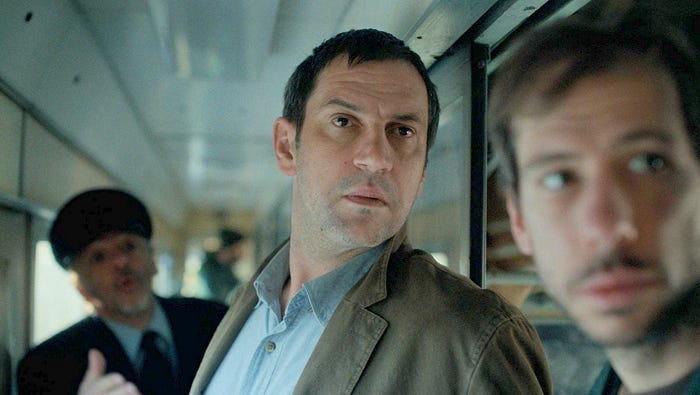Short Films as ‘Playful Things to Think With’
One of my joys at this time of year is watching the Oscar nominated short films. For the last two years, thanks to Shorts.TV, I’ve been able to watch all of the live action and animation nominees at once — in the theater! 🍿🎉
A thought, one that began with the 2020 film short The Present, came into focus for me this year: There are some live action film shorts that qualify as a ‘playful things to think with’. In my post on Why I Believe “Playful Things to Think With” Can Change the World, I describe how a climate focused board game can make complex ideas more accessible — and personally relevant. The three films I’ll list below also do exactly this, albeit in a quite different way. Using the short film format, each of these ‘things’ bring us — however briefly — into another world, a world where we can understand, feel, and reflect on a truly challenging topic.
Note: While I tend to focus on actual “things” that give physical form to an idea — “things” as objects that extend our thinking into the world around us (card decks, canvases, sticky notes, board games, etc.) — I think these films qualify as thinking ‘things’ in a different way. As with a metaphor, analogy, or framework that transforms our thinking, I believe a complex situation — when distilled down to a challenge and choice — can also be a potent ‘thing’ to think with, even without being tangible.
What the three short films I’ve selected below do is to show us people in difficult situations.
- People, we identify and empathize with.
- Situations, we can relate to, however indirectly.
These short films contextualize a distant problem into something I can feel… Even if I’ll never be in that situation, I am — for the duration of that film — immersed into that experience.
Okay, onto the shorts…
A Lien
My personal pick for best short film, was A Lien. Of all the shorts, it was the one that I felt, viscerally. My heart was pounding, and I was left aware of and outraged by a cruel practice that U.S. Immigration and Customs Enforcement uses to catch non-citizens. In the short film, we ride along with a husband and wife (and their adorable daughter) rushing to make a mandatory immigration interview. These are people, making every effort to comply with U.S. immigration laws, thrust into a nightmare situation. As viewers, we experience everything in real-time.
The tight widescreen framing and shaky handheld shooting style amplify the stress of a situation that’s all the more potent for not trying to pin a happy ending on such an upsetting policy.
As things get worse… and worse… I found myself repeatedly asking “What would I do in this situation?”
I felt the helplessness.
I felt angered by the catch-22 of the entire situation.
I’m haunted by that straightforward question: “What would I do in this situation?” as I don’t have an answer. But it’s something I continue to think about. What might I do in this situation? What might I do for people who experience this? I keep thinking about this…
The Man Who Could Not Remain Silent
Similar to A Lien, the Croatian short The Man Who Could Not Remain Silent also thrusts us into a real-time situation, this time aboard a train traveling through Bosnia in 1993.

We feel the bewilderment of the passengers, as the train is stopped and heavily armed men come aboard and begin checking IDs. We feel the intimidation and confusion, unsure about who this group is or what they’re doing, and under whose authority. We see some passengers being taken off the train and loaded into the back of a truck, but no more information is provided. More acutely, we feel the anxiety and stress, as we learn that one of the passengers sitting with us in this train car does not have his ID. As with A Lien, we’re asked “What would I do in this situation?” However, in this case there are multiple characters we can identify with, which this leaves us with a second question: “Who would I be in this situation?” Again, a frustrating situation, with a certain amount of helplessness.
In retrospect, I found myself reflecting on these first two shorts, and wondering: When a country is sliding into lawlessness, where is the line between lawful obedience and resistance?
Anuja
Named for its 9-year-old protagonist, Anuja introduces us to a brilliant girl given the chance to to attend school — and escape her life as an exploited worker in an illegal sweatshop. But her choice is a difficult one, one that will affect not just her, but her sister as well.
We watch as Anuja must make this difficult choice between two paths. As viewers, we can clearly see that one is exploitative, while the other may lift her up out of her current situation. Both have risks and consequences. Given this description, you’d think this short film would be the exemplar of everything I’m proposing here. People. Situation. Choice. Conflict. Watching this, however, I felt like it was a bit heavy-handed. Unlike the two other short films I’ve selected here, Anuja doesn’t leave us to wrestle with “What would I do in this situation?” as the “right” answer is kind of obvious.
That said…
It’s the backstory at the end of the film that matters most. While we never get to see Anuja’s decision, we do learn that the director cast a girl who’d been rescued from a similar fate to play Anuja, and uses the project to inspire kids in similar circumstances.
So… yes. The film is being used to facilitate a conversation; it is being used as a “thing to think with…” with the intended audience.
🤷♂️
My Reflections:
For me, these short films wrap a difficult choice into a highly concentrated, emotional, narrative. We have context, often learning about places and people we may never encounter, otherwise, and we have a conflict, a fundamentally human conflict we can identify with and relate to. But, as a thing to think with, we are left to make a difficult choice, to explore possible answers to the difficult question.
For actual and lasting change, I believe you have to leave the question unanswered. Answering is the job of the viewer. Tread any further as creator of these shorts — tell us what or how to think — and you undercut the work. When we’re told what to think, one of two things tends to happen: If we already support the idea, we become cheerleaders; we feel seen and emboldened. But, those who disagree with what they’re being told, the ones you’d like to reach, the ones whose minds you’d like to change — they dismiss it all. The best shorts let the question(s) linger, and curl up inside of us. And, if the story has enough structure, enough scaffolding to shape our thinking, then the number of possible satisfactory answers will be naturally narrowed. Thinking can be steered, without ever taking the wheel.
I see this subset of film shorts — the ones focused on social issues — like I do cases in the business world, or a critical choice in a gamebook. We find ourselves into a life other than our own, confronted by a complex situation with no clear answer… But, we must choose. We must choose — through the vehicle of a fictional (even if fact-based) scenario — who we’d like to be, and not be.
